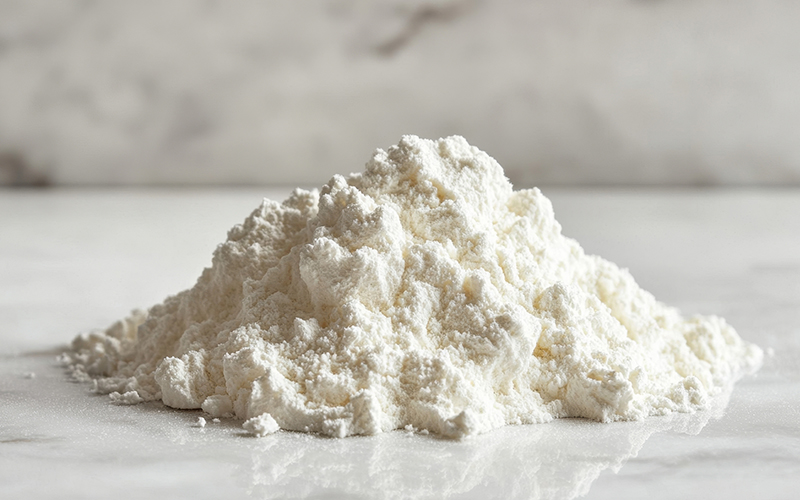Titanium dioxide is one of those ingredients that nearly every soap and cosmetic maker has encountered. It has been used in cosmetics for many decades, mainly as a white pigment to lighten products or to give them opacity. In soap, for example, titanium dioxide is commonly added to make the base whiter or to create color contrast. In makeup, it provides coverage and helps create that smooth, opaque finish. It has also been used in sunscreens and drugs, and even food.
It is a naturally occurring mineral and is typically processed into a fine white powder. Due to its stability, low reactivity, and high effectiveness, it has become one of the most widely used colorants in personal care products. Unlike some dyes and pigments that may have restrictions or safety concerns, titanium dioxide has consistently been considered low risk in topical products.
Over the years, titanium dioxide has gained a reputation for being both useful and safe. Recently, however, there has been increasing controversy and confusion, especially as regulations and court rulings have shifted.
Let’s take a closer look at titanium dioxide in cosmetics, what the science and regulations actually say, and why it remains a safe ingredient when used properly.
The EU Ban on Food Use
Part of the current confusion about titanium dioxide comes from decisions made in Europe regarding its use in food. In 2022, the European Commission banned titanium dioxide as a food additive. This decision was based on questions about whether nanoparticles of titanium dioxide could potentially cause DNA damage if ingested over time.
The important point to understand is that this decision only applies to eating titanium dioxide—not applying it to the skin. The route of exposure makes all the difference. What may be a concern in the digestive system is not the same as topical use in cosmetics. (The US allows titanium dioxide (with some limitations) as a colorant in food.)
Inhalation Concerns
In 2010, the International Agency for Research on Cancer (IARC) did a reassessment of inhaled poorly soluble particles—including titanium dioxide. Based on this evaluation, IARC classified inhaled titanium dioxide dust as Group 2B (“possibly carcinogenic to humans”).
In 2020, after a review of the data, the European Scientific Committee on Consumer Safety issued their report which cautioned against inclusion of titanium dioxide in loose powders and aerosol products at higher concentrations, but found that it is safe in creams, soaps, pressed powders, and other non-airborne cosmetic products.
The current EUJ regulations still allow titanium dioxide in cosmetics, with some limitations when it comes to products that could be inhaled.
The main safety issue with titanium dioxide is not about it being applied to the skin, but about inhalation. When titanium dioxide is in the form of a fine airborne dust, such as in loose powders or sprays, inhaling it could pose a risk. This is not unique to titanium dioxide—many fine powders can be harmful when inhaled.
California’s Prop 65 and Recent Court Rulings
Following that, in 2011, California added titanium dioxide in “airborne, unbound particles of respirable size”) to it’s Prop 65 list as a “chemical known to the State of California to cause cancer.”
Here in the United States, titanium dioxide was added to California’s Proposition 65 list, in 2011, based on its reclassification by the International Agency for Research on Cancer. Specifically, the listing applies to “airborne, unbound particles of respirable size.” Again, this was about inhalation, not topical use.
The listing opened the door for lawsuits against cosmetic and personal care companies, with claims that they needed to include cancer warnings on any products containing titanium dioxide. This was particularly troubling because the warnings were misleading; they suggested a cancer risk from normal cosmetic use, which is not supported by the science.
In August 2025, a federal court ruled that requiring a Prop 65 warning for cosmetics containing titanium dioxide violates the First Amendment1. The court found that the warning was not accurate and would mislead consumers. This ruling effectively blocks enforcement lawsuits and is a significant confirmation that titanium dioxide in cosmetics, as they are normally formulated and used, does not pose a cancer risk.
Safety Reviews and Hazard Information
For decades, the scientific consensus has been that titanium dioxide, when applied to the skin in creams, lotions, soaps, and pressed powders, does not penetrate the skin and does not present a hazard. That view is still upheld today.
Several authoritative bodies have reviewed the use of titanium dioxide in cosmetics. In the US, it has been approved for use as a color additive in cosmetics and drugs since 1977. The European SCCS has repeatedly concluded that titanium dioxide is safe for use on skin in concentrations up to 25%, provided the product is not designed to be inhaled.
Looking at chemical safety data, titanium dioxide is generally considered inert. Safety Data Sheets (SDS) for cosmetic-grade titanium dioxide note that the primary hazard is inhalation of airborne dust in industrial or manufacturing settings. PubChem and other chemical databases echo the same point: titanium dioxide is not toxic by skin contact and does not penetrate the skin barrier. Occupational guidelines, such as those established by the National Institute for Occupational Safety and Health (NIOSH), set exposure limits for workers who handle bulk powders on a daily basis. These conditions are far removed from how the average consumer uses cosmetics.
Why Titanium Dioxide Remains Safe
Taken together, the scientific evidence, regulatory reviews, and recent court rulings tell a consistent story. Titanium dioxide is safe for use in cosmetics, especially when used in creams, soaps, lotions, and pressed powders where inhalation is not a concern. The controversy about food use should not be confused with cosmetic safety. And while inhalation of airborne dust may be a valid concern in industrial settings or in aerosolized cosmetic products, that is not the way most handmade or small-batch cosmetics are made or used.
For makers, titanium dioxide still remains one of the best and safest options for whitening soap or adding opacity to lotions, creams, and other products. Consumers can feel confident that its presence on an ingredient list does not pose a risk.
Final Thoughts
When headlines raise questions about ingredient safety, it can be difficult to sort out the facts. With titanium dioxide, the important distinctions are between food use versus cosmetic use, and inhalation exposure versus topical application. Once those distinctions are clear, the picture becomes much less alarming.
Titanium dioxide has a long history of safe use in cosmetics. Its safety has been extensively studied, repeatedly reviewed by scientific committees, and confirmed by recent legal rulings. In the end, titanium dioxide remains a safe, reliable, and effective ingredient in cosmetic and personal care products (just don’t snort it!)
- The reasoning for the violation of the First Amendment is that it REQUIRES speech when there is no proven reason why it is in the best interests of the state … because the IARC findings were that it could possibly contribute to cancer in high concentrations, not that it would do so. ↩︎


Leave a Reply